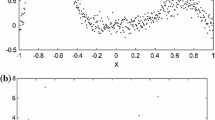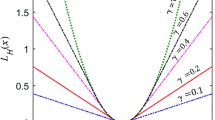Abstract
As real world data sets in general contain noise, construction of robust regression learning models to fit data with noise is an important and challenging research problem. It is all the more difficult to learn regression function with good generalization performance for input samples corrupted by asymmetric noise and outliers. In this work, we propose novel robust regularized support vector regression models with asymmetric Huber and ε-insensitive Huber loss functions leading to strongly convex minimization problems in simpler form whose solutions are obtained by simple functional iterative method. Numerical experiments performed on (1) synthetic data sets with different noise models and having outliers; (2) real world data sets, clearly show the effectiveness and applicability of the proposed support vector regression models with asymmetric Huber loss.



Similar content being viewed by others
References
Balasundaram S, Kapil (2010) On Lagrangian support vector regression. Expert Syst Appl 37:8784–8792
Box GEP, Jenkins GM (1976) Time series analysis: forecasting and control. Holden-Day, San Francisco
Camps-Valls G, Bruzzone L, Rojo-Alvarez JL (2006) Robust support vector regression for biophysical variable estimation from remotely sensed images. IEEE Geosci Remote Sens Lett 3(3):339–343
Chapelle O (2007) Training a support vector machine in the primal. Neural Comput 19(5):1155–1178
Chen C, Yan C, Guo B, Liu G (2017) A robust algorithm of support vector regression with a trimmed Huber loss function in the primal. Soft Comput 21(18):5235–5243
Chu W, Keerthi SS, Ong CJ (2004) Baysian support vector regression using a unified loss function. IEEE Trans Neural Netw 15(1):29–44
Chuang CC, Lee ZJ (2011) Hybrid robust support vector machines for regression with outliers. Appl Soft Comput 11:64–72
Chuang CC, Su SF, Jeng JT, Hsiao CC (2002) Robust support vector regression networks for function approximation with outliers. IEEE Trans. Neural Netw. 13(6):1322–1330
Cristianini N, Shawe-Taylor J (2000) An introduction to support vector machines and other kernel based learning method. Cambridge University Press, Cambridge
Demsar J (2006) Statistical comparisons of classifiers over multiple data sets. J Mach Learn Res 7:1–30
Gretton A, Doucet A, Herbrich R, Rayner PJW, Scholkopf B (2001) Support vector regression for black-box system identification. In: Proceedings of the 11th IEEE workshop on statistical signal processing
Guitton A, Symes WW (2003) Robust inversion of seismic data using the Huber norm. Geophysics 68(4):1310–1319
Guyon I, Weston J, Barnhill S, Vapnik V (2002) Gene selection for cancer classification using support vector machine. Mach Learn 46:389–422
Hao P-Y (2017) Pairing support vector algorithm for data regression. Neurocomputing 225:174–187
Huang X, Shi L, Pelckmans K, Suykens JAK (2014) Asymmetric v-tube support vector regression. Comput Stat Data Anal 77:371–382
Huang X, Shi L, Suykens JAK (2014) Support vector machine classifier with pinball loss. IEEE Trans Pattern Anal Mach Intell 36(5):984–997
Huang X, Shi L, Suykens JAK (2014) Asymmetric least squares support vector machine classifiers. Comput Stat Data Anal 77:371–382
Huber PJ, Ronchetti EM (2009) Robust statistics, 2nd edn. Wiley, New York
Hubert M, Rousseeuw P, Verdonck T (2009) Robust PCA for skewed data and its outlier map. Comput Stat Data Anal 51:2264–2274
Kassam SA, Moustakides G, Shin JG (1982) Robust detection of known signals in asymmetric noise. IEEE Trans Inf Theory IT 28(1):84–91
Lin CF, Wang SD (2002) Fuzzy support vector machine. IEEE Trans Neural Netw 13(2):464–471
Liu M, Xu C, Xu C, Tao D (2017) Fast SVM trained by divide-and-conquer anchors. In: Proceedings 26th international conference on artificial intelligence (IJCAI-17), pp 2322–2328
Madsen K, Nielsen HB (1990) Finite algorithms for robust linear regression. BIT 30:682–699
Mangasarian OL, Musicant D (2000) Robust linear and support vector regression. IEEE Trans Pattern Anal Mach Intell 22(9):950–955
Min JE, Lee YC (2005) Bankruptcy prediction using optimal choice of kernel function parameters. Expert Syst Appl 28(4):603–614
Osuna F, Freund R, Girosi F (1997) Training support vector machines: an application to face detection. In: Proceediings of the computer vision and pattern recognition, pp 130–136
Peng X, Xu D, Shen J (2014) A twin projection support vector machine for data regression. Neurocomputing 138:131–141
Scholkopf B, Smola AJ, Williamson RC, Bartlett PL (2000) New support vector algorithms. Neural Comput 12(5):1207–1245
Sjoberg J, Zhang Q, Ljung L, Berveniste A, Delyon B, Glorennec P, Hjalmarsson H, Juditsky A (1995) Nonlinear black-box modeling in system identification: a unified overview. Automatica 31:1691–1724
Smola AJ (1998) Regression estimation with support vector learning machines, Master’s thesis. Technical Univ, Munchen, Munich, Germany
Suykens JAK, De Brabanter J, Lukas L, Vandewalle J (2002) Weighted least squares support vector machines: robustness and sparse approximation. Neurocomputing 48(1):85–105
Suykens JAK, Gestel Van, De Brabanter J, De Moor B, Vandewalle J (2002) Least squares support vector machines. World Scientific, Singapore
Takeuchi I, Bengio Y, Kanamori T (2001) Robust regression with asymmetric heavy-tail noise distributions, Technical Report 1198, Universite de Montreal
Vapnik VN (2000) The nature of statistical learning theory, 2nd edn. Springer, New York
Wang X, Tan L, He L (2014) A robust least squares support vector machine for regression and classification with noise. Neurocomputing 140:41–52
Ye YF, Bai L, Hua XY, Shao YH, Wang Z, Deng NY (2016) Weighted Lagrange ε-twin support vector regression. Neurocomputing 197:53–68
You S, Xu C, Wang Y, Xu C and Tao D (2017) Privileged multi-label learning. In: Proceedings of the 26th international conference on artificial intelligence (IJCAI-17), pp 3336–3342
Zhang XG (1999) Using class-centre vectors to build support vector machines. In: Proceedings of the IEEE signal processing Society workshop, New York, IEEE Press, pp 3–11
Zhao Y, Sun J (2008) Robust support vector regression in the primal. Neural Networks 21:1548–1555
Zhu J, Hoi SCH, Lyu MRT (2008) Robust regularized kernel regression. IEEE Trans Syst Man Cybern Part B Cybern 38(6):1639–1644
Acknowledgements
The authors are extremely thankful to the anonymous reviewers for their constructive comments. Mr.Yogendra Meena acknowledges the financial assistance awarded by Rajiv Gandhi National Fellowship, Government of India.
Author information
Authors and Affiliations
Corresponding author
Additional information
Publisher’s Note
Springer Nature remains neutral with regard to jurisdictional claims in published maps and institutional affiliations.
Rights and permissions
About this article
Cite this article
Balasundaram, S., Meena, Y. Robust Support Vector Regression in Primal with Asymmetric Huber Loss. Neural Process Lett 49, 1399–1431 (2019). https://doi.org/10.1007/s11063-018-9875-8
Published:
Issue Date:
DOI: https://doi.org/10.1007/s11063-018-9875-8




